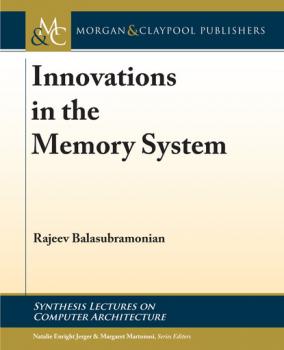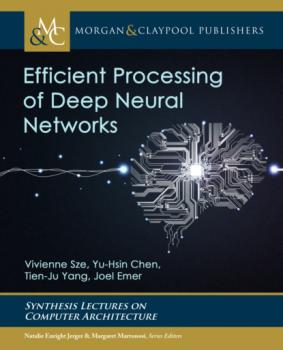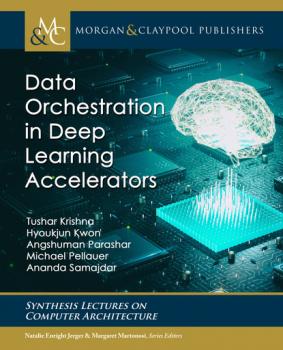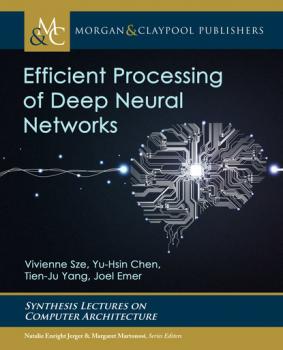Synthesis Lectures on Computer Architecture
Скачать книги из серии Synthesis Lectures on Computer ArchitectureEfficient Processing of Deep Neural Networks
This book provides a structured treatment of the key principles and techniques for enabling efficient processing of deep neural networks (DNNs). DNNs are currently widely used for many artificial intelligence (AI) applications, including computer vision, speech recognition, and robotics. While DNNs deliver state-of-the-art accuracy on many AI tasks, it comes at the cost of high computational complexity. Therefore, techniques that enable efficient processing of deep neural networks to improve key metrics—such as energy-efficiency, throughput, and latency—without sacrificing accuracy or increasing hardware costs are critical to enabling the wide deployment of DNNs in AI systems. The book includes background on DNN processing; a description and taxonomy of hardware architectural approaches for designing DNN accelerators; key metrics for evaluating and comparing different designs; features of DNN processing that are amenable to hardware/algorithm co-design to improve energy efficiency and throughput; and opportunities for applying new technologies. Readers will find a structured introduction to the field as well as formalization and organization of key concepts from contemporary work that provide insights that may spark new ideas.
Efficient Processing of Deep Neural Networks
This book provides a structured treatment of the key principles and techniques for enabling efficient processing of deep neural networks (DNNs). DNNs are currently widely used for many artificial intelligence (AI) applications, including computer vision, speech recognition, and robotics. While DNNs deliver state-of-the-art accuracy on many AI tasks, it comes at the cost of high computational complexity. Therefore, techniques that enable efficient processing of deep neural networks to improve key metrics—such as energy-efficiency, throughput, and latency—without sacrificing accuracy or increasing hardware costs are critical to enabling the wide deployment of DNNs in AI systems. The book includes background on DNN processing; a description and taxonomy of hardware architectural approaches for designing DNN accelerators; key metrics for evaluating and comparing different designs; features of DNN processing that are amenable to hardware/algorithm co-design to improve energy efficiency and throughput; and opportunities for applying new technologies. Readers will find a structured introduction to the field as well as formalization and organization of key concepts from contemporary work that provide insights that may spark new ideas.
A Primer on Memory Consistency and Cache Coherence
Many modern computer systems, including homogeneous and heterogeneous architectures, support shared memory in hardware. In a shared memory system, each of the processor cores may read and write to a single shared address space. For a shared memory machine, the memory consistency model defines the architecturally visible behavior of its memory system. Consistency definitions provide rules about loads and stores (or memory reads and writes) and how they act upon memory. As part of supporting a memory consistency model, many machines also provide cache coherence protocols that ensure that multiple cached copies of data are kept up-to-date. The goal of this primer is to provide readers with a basic understanding of consistency and coherence. This understanding includes both the issues that must be solved as well as a variety of solutions. We present both high-level concepts as well as specific, concrete examples from real-world systems. This second edition reflects a decade of advancements since the first edition and includes, among other more modest changes, two new chapters: one on consistency and coherence for non-CPU accelerators (with a focus on GPUs) and one that points to formal work and tools on consistency and coherence.
Deep Learning for Computer Architects
Machine learning, and specifically deep learning, has been hugely disruptive in many fields of computer science. The success of deep learning techniques in solving notoriously difficult classification and regression problems has resulted in their rapid adoption in solving real-world problems. The emergence of deep learning is widely attributed to a virtuous cycle whereby fundamental advancements in training deeper models were enabled by the availability of massive datasets and high-performance computer hardware. This text serves as a primer for computer architects in a new and rapidly evolving field. We review how machine learning has evolved since its inception in the 1960s and track the key developments leading up to the emergence of the powerful deep learning techniques that emerged in the last decade. Next we review representative workloads, including the most commonly used datasets and seminal networks across a variety of domains. In addition to discussing the workloads themselves, we also detail the most popular deep learning tools and show how aspiring practitioners can use the tools with the workloads to characterize and optimize DNNs. The remainder of the book is dedicated to the design and optimization of hardware and architectures for machine learning. As high-performance hardware was so instrumental in the success of machine learning becoming a practical solution, this chapter recounts a variety of optimizations proposed recently to further improve future designs. Finally, we present a review of recent research published in the area as well as a taxonomy to help readers understand how various contributions fall in context.
Quantum Computing for Computer Architects
Quantum computers can (in theory) solve certain problems far faster than a classical computer running any known classical algorithm. While existing technologies for building quantum computers are in their infancy, it is not too early to consider their scalability and reliability in the context of the design of large-scale quantum computers. To architect such systems, one must understand what it takes to design and model a balanced, fault-tolerant quantum computer architecture. The goal of this lecture is to provide architectural abstractions for the design of a quantum computer and to explore the systems-level challenges in achieving scalable, fault-tolerant quantum computation.
In this lecture, we provide an engineering-oriented introduction to quantum computation with an overview of the theory behind key quantum algorithms. Next, we look at architectural case studies based upon experimental data and future projections for quantum computation implemented using trapped ions. While we focus here on architectures targeted for realization using trapped ions, the techniques for quantum computer architecture design, quantum fault-tolerance, and compilation described in this lecture are applicable to many other physical technologies that may be viable candidates for building a large-scale quantum computing system. We also discuss general issues involved with programming a quantum computer as well as a discussion of work on quantum architectures based on quantum teleportation. Finally, we consider some of the open issues remaining in the design of quantum computers.
Table of Contents: Introduction / Basic Elements for Quantum Computation / Key Quantum Algorithms / Building Reliable and Scalable Quantum Architectures / Simulation of Quantum Computation / Architectural Elements / Case Study: The Quantum Logic Array Architecture / Programming the Quantum Architecture / Using the QLA for Quantum Simulation: The Transverse Ising Model / Teleportation-Based Quantum Architectures / Concluding Remarks









